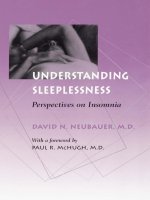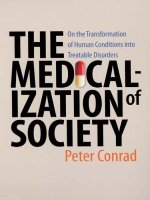the johns hopkins university press pregnancy and parenting after thirty-five mid life new life mar 2006
Bạn đang xem bản rút gọn của tài liệu. Xem và tải ngay bản đầy đủ của tài liệu tại đây (1.21 MB, 297 trang )
PREGNANCY and PARENTING
after THIRTY-FIVE
A Johns Hopkins Press
Health Book
PREGNANCY and PARENTING
after THIRTY-FIVE
Mid Life, New Life
Michele C. Moore, M.D.
Caroline M. de Costa, M.D.
the johns hopkins university press
baltimore
© 2006 Michele C. Moore, M.D., and Caroline M. de Costa, M.D.
All rights reserved. Published 2006
Printed in the United States of America on acid-free paper
9 8 7 6 5 4 3 2 1
The Johns Hopkins University Press
2715 North Charles Street
Baltimore, Maryland 21218-4363
www.press.jhu.edu
Library of Congress Cataloging-in-Publication Data
Moore, Michele.
Pregnancy and parenting after thirty-fi ve: mid life, new life / Michele C. Moore,
Caroline M. de Costa.
p. cm.
Includes bibliographical references and index.
ISBN 0-8018-8320-2 (hardcover : alk. paper)—ISBN 0-8018-8321-0 (pbk. : alk. paper)
1. Pregnancy in middle age 2. Childbirth in middle age. 3. Middle-aged mothers.
I. De Costa, Caroline, 1947– II. Title.
RG556.6.M66 2006
618.2—dc22 2005018223
A catalog record for this book is available from the British Library.
Contents
Acknowledgments vii
Introduction 1
Part One PLANNING A PREGNANCY
1. Thinking about Pregnancy 11
2. Making Choices about Work 16
3. Fathers, Partners, and Surrogate Fathers 21
Part Two GETTING PREGNANT
4. Natural Conception 29
5. Assistance with Conception 37
6. Assisted Reproductive Technology 48
7. Medical Conditions That May Affect Pregnancy 60
8. Pregnancy following Cancer and Precancer 80
9. Other Roads to Motherhood 86
Part Three BEING PREGNANT
10. Screening for Chromosomal Abnormalities 95
11. Prenatal Tests 113
12. Miscarriage 12 1
13. Termination of Pregnancy 125
14. Lifestyle during Pregnancy 129
15. Minor Maladies of Pregnancy 137
16. Pregnancy Month by Month 147
17. Assessment of Fetal Well-being 159
18. Problems That May Arise during Pregnancy 163
19. Twin Pregnancy 177
Part Four BIRTH
20. The Process of Birth 185
21. The Experience of Birth 189
22. Pain Relief in Labor 195
23. Problems That May Arise during Labor 199
24. Operative Vaginal Delivery 206
25. Cesarean Section 209
Part Five AFTER THE BIRTH
26. Going Home with Your Baby 229
27. Breastfeeding 236
28. Being an Older Parent 242
Appendices
A.Drugs and Other Substances That Are Harmful to the
Fetus 245
B. Drugs and Chemicals Not Shown to Be Harmful to the
Pregnant Woman or Fetus 247
C. Body Mass Index Table 248
D. Caffeine Content of Common Sources 249
E. Iron-rich Foods 250
F. Calcium-rich Foods 252
G.The Loss of a Baby 255
H.Summary of Medical Tests 257
Glossary 267
Resources 275
Index 279
vi Contents
Acknowledgments
We wish to thank Dr. Jeanne Wiebenga for her expert critical read-
ing of our manuscript, Dr. Bob Miller for sharing his expertise on
ART, and Cairns Base Hospital Library and its staff for helping us in
our research. Our agent, Sally Brady, has been an unending source
of encouragement and help. Javed de Costa and Josie Valese have
been always willing to help with the fi ner points of word processing
and computer vagaries. We thank Jacqueline Wehmueller, our edi-
tor, who requested that we write this book.
Last, but far from least, we thank our families, for their forbear-
ance as we disappeared behind piles of paper, and the patients
whose experiences we bring to this work.
This page intentionally left blank
PREGNANCY and PARENTING
after THIRTY-FIVE
This page intentionally left blank
Introduction
As you have probably discovered, there are many books about the
physical changes of pregnancy, the normal growth of the baby, the
search for a birth attendant, whether that person should be a doctor
or a midwife, what happens in normal labor, and how to care for a
newborn baby. However, few of these books speak authoritatively
on these topics as they relate to a woman experiencing a pregnancy
at a later time in her reproductive years. Those that do tend to be
highly subjective and may be politically biased. This is OK; most
people have a very personal viewpoint of childbirth, usually based
on their own experience. But, there are many different ways of
looking at the subject, and it is important for women over 35 to
have the particular medical facts that apply to them.
The authors of this book are women and doctors, with a com-
bined experience of over fi fty years of caring for women; we are
also mothers ourselves, and we feel very strongly that all women
have the right to be informed, not only about how pregnancy and
childbirth usually and normally proceed, but also about what can
go wrong, and why, and what can be done about it. In this book we
have tried to present this information in an unbiased way, so that
each woman can make the best-informed choices for herself and
her baby.
Trends in Later-life Pregnancies
Everyone who reads a newspaper knows that many women—single
or wed, in committed or casual relationships, for career or personal
reasons—are deferring pregnancy until their later reproductive
years. The median age of childbearing women in Massachusetts is
now 30 years, whereas it was around 25 just twenty years ago. The
U.S. Census shows that childlessness has doubled in the past twen-
1
ty years and that one in every fi ve women, or 20 percent, in the age
group 40 to 45 has never had a child. For women 40 and younger
who have professional training or graduate degrees, the fi gure is
47 percent. Economist Sylvia Hewlett, in her recent book Creat-
ing a Life: Professional Women and the Quest for Children, described
a group of nearly 2,000 “high-achieving” women in business, law,
and medicine and found that 42 percent were still childless after
the age of 40; in the higher-paid echelons, the fi gure was closer to
50 percent. As Hewlett explains, and we will be discussing, not
all of these women were childless by choice; but certainly most of
them initially deferred their plans and hopes for children because
they were pursuing career paths in competition with men, for whom
having a family is not a hindrance to advancement in their jobs.
In the year 2000 in the United States, 546,674 women over age
35 had their fi rst child. Successful intentionally deferred pregnan-
cies are often popularly viewed as the typical “pregnancy after 35,”
but there are many other patterns of later pregnancy. Some women
had children at a younger age and then decide for a variety of rea-
sons to have one or more children later in life. Perhaps a woman
who has been widowed or divorced remarries or re-partners and
wants to have a child with her new spouse or partner; others may
Table 1. Live Births in United States by Age of Mother and Birth Order
All Ages 35–39 40–44 45–49 50–54
First baby 1,622,404 100,334 18,959 1,053 84
(40%) (2.5%) (0.5%) (0.026%) (0.002%)
Third baby 676,597 106,281 18,748 725 42
(17%) (2.6%) (0.46%) (0.018%) (0.001%)
Fifth baby 95,200 22,208 6,160 306 12
(2.3%) (0.5%) (0.15%) (0.007%) (0.0003%)
Eighth baby 18,342 6,991 3,953 403 18
or beyond (0.45%) (0.17%) (0.097%) (0.0099%) (0.0004%)
Total 4,058,814 452,057 90,013 4,349 255
(100%) (11%) (2.2%) (0.1%) (0.006%)
Source: Data from 2002 National Vital Statistics Report.
2 Introduction
always have wanted a large family and so continue bearing children
well into their forties; some women may fi nd themselves uninten-
tionally pregnant and decide to carry on with the pregnancy; some
infertile women, because of the time and money involved in infer-
tility treatment, are well into their later childbearing years before
they successfully conceive. There are many reasons for later child-
bearing; the basic facts may be similar among different women, but
the nuances are unique to each situation.
A Few Words about Medical
Interventions in Childbirth
Much of the available literature on pregnancy deals with what has
become known as “natural” childbirth and campaigns for minimal
intervention during pregnancy and labor. It advocates avoiding
epidurals and other forms of pain management, espouses the supe-
riority of home births with midwives in attendance, and discour-
ages use of Cesarean section delivery. Its arguments are often highly
emotional and view “natural” childbirth as sacrosanct. This mind-
set is essentially a reaction to what we freely admit was excessive
use of medical interventions in the processes of childbirth, a trend
which reached its height in the 1980s. Most of these interventions
were devised by doctors seeking to decrease death or damage to
women and their babies in the course of pregnancy and birth. The
interventions sometimes involved technologies that were new and,
like many new things, had not yet revealed their limitations.
Certainly, the chances of a mother or baby dying during preg-
nancy or childbirth are now very much less than they were as re-
cently as 1970, and most babies are now born alive and healthy.
This happy situation is partly due to advances in obstetric care of
mothers and in pediatric care of newborn babies, but it is also be-
cause women have become healthier, and a healthy mother is the
best starting point for a healthy pregnancy outcome.
The campaign for less medical intervention and more involve-
ment of women in decisions about their health care during preg-
nancy has been good in that it has led to the questioning of much
Introduction 3
dogma about obstetric care (for example, the necessity of shaves,
enemas, and masks; the routine use of episiotomies and stirrups for
normal births), and the movement has given many women a great-
er sense of control over what happens to them during pregnancy
and labor. However, in our view this campaign has sometimes gone
too far. In some instances, women are presented with rigid views
of what constitutes femininity and its association with childbirth,
with no allowance for individual circumstances. Women can end
up feeling that the process of labor is a challenge at which they
will either succeed or fail. This is both factually incorrect and mor-
ally wrong: there are many different ways of approaching pregnancy
and childbirth, some of them medical, some not. Each woman is
an individual, and her individual needs and preferences must be
honored.
In most developed countries in the twenty-fi rst century, birth,
even for those desiring minimal intervention, still involves some
contact with the medical and paramedical professions, and most
babies are born in hospitals. The rationale behind hospital birth is
that there need be no intervention if all is going well, but all the
bells and whistles of modern medicine are near at hand, with the
expert personnel to employ them, should a problem arise. Some
people believe that home birth with the possibility of transfer to a
hospital is as safe an option for mother and baby as hospital birth,
and the example of Holland is often used. Holland is small in area
and the population is densely clustered in urban areas. Home birth
is a popular and relatively safe option there (about 30 percent of
women choose it) at least partly because of very quick transit from
home to the hospital for women experiencing any problems during
birth. In larger countries such as the United States, Canada, and
Australia, access to well-equipped hospitals is not usually as rapid
and straightforward, so home birth is a less safe option for mothers,
and particularly for babies.
The existence of modern technology does not negate the fact
that signifi cant risks to mothers and babies do still exist. Today in
the United States, 20 to 24 percent of babies are born by Cesar-
ean section, and the choice of this delivery method is usually made
because of unacceptable risk to the mother or the baby if the preg-
4 Introduction
nancy or labor is allowed to continue. Another 5 to 10 percent of
fi rst babies are born with the assistance of forceps or the vacuum
extractor, for similar reasons. The advantage of modern medical
technology is that the risks to mother and baby can generally be de-
tected early or anticipated. When we know about risks in advance,
it is far easier to take the appropriate steps to eliminate or mini-
mize them. Many tests are available to women during pregnancy
and labor, and some of these are especially relevant for the older
mother. Other tests are routinely recommended for babies just after
birth. These tests are well researched, supported by evidence in the
medical literature, and offered because they provide protection and
improved outcomes for mother and baby.
It has become widely accepted that pregnant women should
have choices about how, where, and when they give birth, and
we heartily concur. Most pregnancies proceed completely without
signifi cant complications, as do most labors and births, with the
longed-for outcome of a healthy baby and delighted parents. How-
ever, it is only after the event that a birth can be judged to have
been completely normal: pregnancy and birth do have the poten-
tial for going suddenly and dramatically wrong. If this happens, the
presence of experienced obstetricians and midwives and other birth
personnel can literally be lifesaving for a woman or baby. We there-
fore recommend that you carefully consider the issue of your baby’s
safety, and choose where you wish the birth to occur well before
your expected due date. There is no socially or politically correct
way to have a baby; there is only the best way for you. If medical
intervention is necessary for your baby to be born healthy, then so
be it. If childbirth were entirely left to “Nature,” many mothers and
babies would, quite “naturally,” die—as they did in the past. That
this was a frequent occurrence is borne out by meandering through
old graveyards and reading the headstones.
Words like “normal,” “natural,” and “succeed” in the context
of childbirth are often used with judgmental and emotionally mo-
tivated implications. Women sometimes tell us that they feel that
they have “failed” at childbirth, even when they have birthed a
beautiful and healthy baby, because their experience was more
painful, diffi cult, or just plain different from what they had been
Introduction 5
led to expect and because they had accepted medical intervention.
This altogether unjustifi ed reaction is of particular concern when
these feelings of inadequacy interfere with a mother’s happy bond-
ing with her baby. It was for this reason that we wrote our previous
book, Cesarean Section: Understanding and Celebrating Your Baby’s
Birth—so that women who had already undergone or who might
have C-sections would be well informed about the procedure. We
have been similarly motivated in writing this book.
We are not apologists for the medical profession; indeed, many
of our more conservative colleagues feel that our writing is too
radical. We have been told that we should not so clearly describe
some of the possible problems and solutions attendant on birth,
that we risk exposing doctors to litigation. We think that reticence
on these subjects would be a disservice to the women we write for.
Medical intervention in pregnancy or childbirth should occur only
after a thorough explanation and discussion with the woman and
her partner about why it is being suggested; we know, however, that
situations arise in pregnancy and childbirth that necessitate urgent
decisions. Because of these possibilities, we believe that having ac-
cess to information well in advance is desirable for every woman,
but especially for women having babies in their later reproductive
years, which is usually accepted to be 35 and over. This information
is also necessary for women just thinking of pregnancy at this stage
in their lives. They have choices that were not available to previ-
ous generations.
Challenges for the Older Mother
For the woman over 35, having a baby has particular challenges:
emotional, social, and medical. Some of the medical conditions
that are more prevalent in older women can complicate pregnancy,
and there are greater risks of certain abnormalities in the baby. We
are all a bit less adaptable as we get older, and it becomes more
diffi cult to make the radical changes in lifestyle that come with
having a baby. The constraints placed on career and fi nancial cir-
cumstances may loom large. Many of these factors apply even when
6 Introduction
a woman has had children at a younger age; imagine the fi nancial
and social strains of simultaneously having a new baby and a child
in college (we’ll introduce you to several women in this situation).
Even when the expectant mother is in her forties, pregnancy
and childbirth usually proceed normally, are trouble-free, and lead
to the spontaneous vaginal delivery of a healthy baby. But it would
be folly to ignore the fact that, statistically, older women are more
likely to miscarry in early pregnancy, to have certain complications
of pregnancy, and to deliver their babies via Cesarean section or
with some other form of operative assistance. This is just how it is,
and ignoring it will not change the facts.
Most women in this age group feel well in control of their lives
and able to plan and execute their life decisions. It is important
for them to realize that they may need to accept medical help—to
conceive, to continue a healthy pregnancy, and to give birth to
a healthy baby. We know about this fi rst-hand, not just from the
women for whom we’ve cared, but by our own experience. Michele
gave birth to her fi rst child, a vigorous boy, at the age of 35, by
means of an emergency Cesarean section. This was totally at odds
with her plans for this birth. Two and a half years later, she gave
birth to her beautiful daughter by an elective C-section. The reali-
ties of being an older mother had sunk in, and she was grateful to be
able to choose the planned C-section birth. Caroline is an example
of women who have had children earlier in life and then decide
later to have more. She has had seven children, the fi rst at age 20
and the fi fth at 33. For family reasons, eight years later, she and her
husband decided on another pregnancy, and a wonderful son was
born when she was 41. He was not the last, however, for at 44 she
gave birth to a delightful daughter—her last child.
We also acknowledge that not all women who become pregnant
in later life planned or welcome the situation, even though they
may proceed with what becomes a much-wanted pregnancy and,
after the birth, a most-cherished child. We will be discussing why
women may feel confl icted about pregnancy.
Introduction 7
About This Book
The book is divided into fi ve sections: “Planning a Pregnancy,”
“Getting Pregnant,” “Being Pregnant,” “Birth,” and “After the
Birth.” Each section fi rst presents normal processes and procedures,
then problems that may arise and how they may be dealt with. Ob-
viously not all of this information will be relevant to every woman;
using the table of contents and index, you can read what is relevant
for you. We also provide a glossary of terms, a comprehensive list of
resources, and several appendices containing specifi c data. We have
not attempted to duplicate the general information about pregnan-
cy and birth which is available in many excellent other books. Our
aim is to deal only briefl y with such general material but to provide
the full spectrum of information needed by an older mother, from
conception through to some often-diffi cult times of caring for chil-
dren when you are the oldest mom at the PTA meeting. The book
addresses such matters as preexisting medical conditions and how
they may affect pregnancy, and diffi culties with conception. Our
approach is not intended to overemphasize problems but rather to
deal with them in a realistic way for the woman who comes to preg-
nancy at a somewhat later age.
While we will occasionally refer to our own personal experienc-
es, mostly we draw upon established knowledge and practice guide-
lines, up-to-date medical literature, and our clinical experience
with patients. We have also included stories of women we have
been privileged to care for. Names and details have been changed.
We thank them all for sharing their stories with us.
8 Introduction
Part One
PLANNING A PREGNANCY
This page intentionally left blank
Chapter 1
Thinking about Pregnancy
Ideally, becoming a parent is a step considered with care. We all
realize that this is not always the case, but as you are reading this
book, you are clearly giving thought to this important decision.
Many conditions in which we fi nd ourselves can be changed, but
once you discover you are pregnant, many processes in your body
have already been set in motion.
There is nearly always a period of days or weeks between concep-
tion and when the woman becomes aware of being pregnant; this
is true even for women who are trying to conceive and are very
focused on what is happening inside them. The actual meeting of
the egg and sperm—conception—happens about two weeks before
the fi rst missed period. Yes, it is true that some women experience
changes in their bodies before they can otherwise have any clues
of pregnancy (Michele was made nauseous by the smell of coffee,
which she loves, almost immediately upon becoming pregnant),
but most women remain uncertain until at least that fi rst missed
period.
Why does this matter? It matters because during the fi rst three
months of pregnancy (the fi rst trimester) the fetus is the most vul-
nerable to outside infl uences that can be healthy or unhealthy for
its development. Optimal maternal health is most important at this
time, and the best way to create this good health is to start before
you conceive. As a woman in your mid-thirties or older, you would
be well advised to have a physical and a chat with your doctor be-
fore attempting conception, with the idea of identifying any par-
ticular challenges you might face during pregnancy—a previously
undetected anemia or borderline high blood pressure, perhaps, or
any one of a host of asymptomatic but potentially problematic
11
conditions. Your doctor will probably want to check that you have
regular, or fairly regular, periods; if you don’t, then you may need
referral to a fertility specialist to help with conception. A breast
exam and mammogram, and a Pap smear, if you haven’t had these
tests recently, may be appropriate. These steps will allow you to
address any important health issues before conceiving and thus to
enter pregnancy at your best.
There are many things you can do to improve your health in the
months before you become pregnant, all of which should continue
into the early weeks of pregnancy and later. Obvious pieces of ad-
vice are: stop smoking, if you do smoke; discontinue that glass of
wine or beer with dinner—or before, or after, or at any other time;
watch your caffeine intake, keeping it at or below two cups of regu-
lar coffee or cola per day (see Appendix D for caffeine content of
coffees, teas, colas, and chocolate). If you partake of “recreational”
drugs, now is the time to stop . . . before conception.
If you need prescription medications, make an appointment
to talk with your doctor about whether the drugs you are taking
are safe during pregnancy, for you and the baby. The solution may
be simple. For instance, Michele recently treated a woman who
needed medication for her high blood pressure but who also wanted
to have a baby. The woman was taking an ACE inhibitor, a very
important and commonly used class of hypertension drug, but one
that can cause problems with a developing baby’s kidneys and uri-
nary system. However, high blood pressure in pregnancy can also
be dangerous, for baby and mother. A change to another class of
blood pressure medication solved the problem for Michele’s pa-
tient. We don’t recommend that you stop your medications on your
own; there is a good reason you are taking these drugs. With your
doctor, come to a solution that will benefi t the health of both you
and your planned baby. In Appendices A and B you will fi nd a list-
ing of medications that may be harmful and ones that are generally
safe to take when you are pregnant. Even if a drug is usually safe,
a good rule of thumb is not to take it unless you truly need it for
your health or you are truly uncomfortable and know that you will
receive relief from it.
This would also be a good time to check and see if you are im-
12 planning a pregnancy
mune to rubella (German measles); if you are not and you are not
yet pregnant, being immunized would be a good step (although you
must then avoid pregnancy for at least two months). And, by “not
yet pregnant” we mean that you have carefully used birth control
and haven’t even tried to get pregnant yet; you don’t want inadver-
tently to take the rubella shot in early pregnancy.
What should you eat when you are planning to get pregnant? A
basic answer in most circumstances would be lean protein, lots of
fruits and vegetables, and whole grains. Included should be sources
of the “good fats” from fi sh and seeds and nuts. Women embarking
on pregnancy can especially benefi t from folic acid. This vitamin
of the B group helps prevent serious abnormalities of the brain and
spinal cord in the developing baby. Because these problems develop
early in the pregnancy, it is good to be aware of your folic acid
intake before you begin trying to become pregnant. Folic acid is
found in abundance in leafy greens, whole grains, oranges, canta-
loupe, milk, bananas, and organic meats. You can hedge your bets
by taking a multiple vitamin every day. Make sure it contains at
least .4 mg (often expressed as 400 micrograms) of folic acid. Do
not take the super-duper megavitamins offered at health food and
nutrition stores, because they may very well have more vitamin A
or C than is advisable for the developing baby. During your chat
with your doctor, you could ask for a prescription for prenatal vi-
tamins and calcium. These are compounded to supply exactly the
micronutrients needed during pregnancy.
If you are very overweight, try to lose weight before you become
pregnant. For many complicated reasons (some of which we will
discuss later), being close to the normal body mass index can make
it easier to become pregnant (see Appendix C). This doesn’t mean
you must go on a crash diet; it does mean eating in a healthy man-
ner and eliminating the extra calories that many of us consume
without even thinking about it. Before putting anything in your
mouth, ask yourself, “Do I really need this? Is this high-quality nu-
trition that will give me vital nutrients, or is it just a high-fat, high-
salt, or high-sugar treat? Am I eating because I’m hungry or because
the food is there and eating is something to do?” Train yourself to
eat only if you are hungry and to stop when you are no longer hun-
Thinking about Pregnancy 13
gry. Eat from the high-quality food categories mentioned above.
Remember that health is the aim, and your waistline is only one
of the indices of health. Aim for a prepregnant waistline measure-
ment of less than 35 inches.
One food to avoid is raw meat; raw meat can be contaminated
with bacteria or parasites and can be a source of toxoplasmosis, a
parasite that older children and adults tolerate well but that can
cause birth defects in a developing baby. Also stay away from un-
pasteurized milk, and cheese or other products made from unpas-
teurized milk, which can be a source of the bacterial infection liste-
riosis, to which pregnant women have a heightened vulnerability.
Nearly everyone’s health program should include exercise. If
you have been a couch potato, prepregnancy is not the time to
start weight lifting and marathon training, but a 30-minute walk
twice daily would benefi t you very much. Or you might enjoy a
daily swim. Do not use a hot tub after your exercise, though; con-
cerns have been raised that elevated maternal body temperatures
in the fi rst trimester of pregnancy can contribute to birth defects.
If you are already very active, you can probably continue with your
regular regime. However, if you are losing weight or if you have any
questions, you should talk with your doctor and see if you need to
modify your exercise program.
We have been asked if it is harmful to work with computers dur-
ing early pregnancy. So far, this has not been shown to be the case,
but do take routine breaks, simply to protect yourself from increased
fatigue. Women who work in settings in which there are chemicals
would be well advised to talk with the safety engineer at work and
ask for “MSDS sheets” on all of the chemicals used. Take these fact
sheets to your doctor and ask him or her to tell you if the chemicals
in use might cause you or the fetus any problems. Again, doing
this research and any self-protection before you become pregnant is
best, but it is an important precaution and can still be helpful after
conception. Doctors and nurses who work with anesthetic gases
may need to take special precautions; discuss this with your own
physician and your chief of service on the job. If you work with
radiation, you should talk with your safety engineer and your own
doctor and be certain what your levels of exposure and risks are.
14 planning a pregnancy









